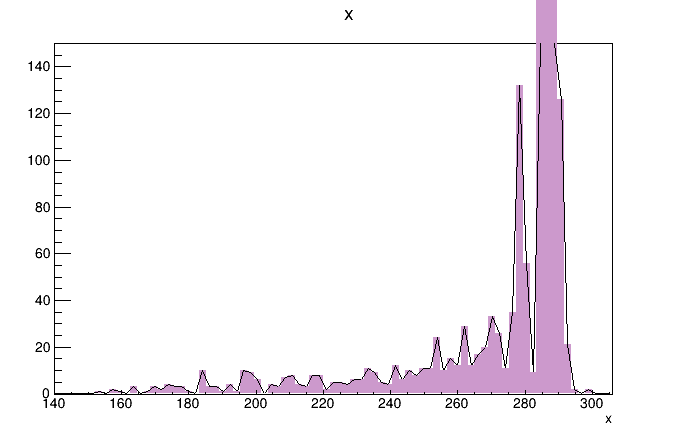Thanks, Coyote, but the question remains the same for me, how to perform automatic detection gaussian fit for multiple peaks. Modifying peaks.C (as per my understanding), isn’t working.
#include "TCanvas.h"
#include "TMath.h"
#include "TH1.h"
#include "TF1.h"
#include "TRandom.h"
#include "TSpectrum.h"
#include "TVirtualFitter.h"
Int_t npeaks = 30;
Double_t fpeaks(Double_t *x, Double_t *par) {
Double_t result = par[0] + par[1]*x[0];
for (Int_t p=0;p<npeaks;p++) {
Double_t norm = par[3*p+2];
Double_t mean = par[3*p+3];
Double_t sigma = par[3*p+4];
result += norm*TMath::Gaus(x[0],mean,sigma);
}
return result;
}
void peaks(Int_t np=10) {
npeaks = TMath::Abs(np);
TTree *t = new TTree("t", "my tree");
t->ReadFile("a.txt", "x/D");
// first, create a histogram ...
TH1D *h = new TH1D("h", "my histo", 200, 130., 330.);
// ... then fill it ...
t->Project("h", "x");
// ... and the histogram is ready for some "peak finding" procedure ...
// ... well, you can draw it, if you like ...
//TCanvas *c = new TCanvas("c", "my canvas");
// h->Draw("HISTO");
TH1F *h = new TH1F("h","test",500,0,1000);
//generate n peaks at random
Double_t par[3000];
par[0] = 0.8;
par[1] = -0.6/1000;
Int_t p;
for (p=0;p<npeaks;p++) {
par[3*p+2] = 1;
par[3*p+3] = 10+gRandom->Rndm()*980;
par[3*p+4] = 3+2*gRandom->Rndm();
}
TF1 *f = new TF1("f",fpeaks,0,1000,2+3*npeaks);
f->SetNpx(1000);
f->SetParameters(par);
TCanvas *c1 = new TCanvas("c1","c1",10,10,1000,900);
c1->Divide(1,2);
c1->cd(1);
h->FillRandom("f",200000);
h->Draw();
TH1F *h2 = (TH1F*)h->Clone("h2");
//Use TSpectrum to find the peak candidates
TSpectrum *s = new TSpectrum(2*npeaks);
Int_t nfound = s->Search(h,2,"",0.10);
printf("Found %d candidate peaks to fit\n",nfound);
//Estimate background using TSpectrum::Background
TH1 *hb = s->Background(h,20,"same");
if (hb) c1->Update();
if (np <0) return;
//estimate linear background using a fitting method
c1->cd(2);
TF1 *fline = new TF1("fline","pol1",0,1000);
h->Fit("fline","qn");
//Loop on all found peaks. Eliminate peaks at the background level
par[0] = fline->GetParameter(0);
par[1] = fline->GetParameter(1);
npeaks = 0;
Float_t *xpeaks = s->GetPositionX();
for (p=0;p<nfound;p++) {
Float_t xp = xpeaks[p];
Int_t bin = h->GetXaxis()->FindBin(xp);
Float_t yp = h->GetBinContent(bin);
if (yp-TMath::Sqrt(yp) < fline->Eval(xp)) continue;
par[3*npeaks+2] = yp;
par[3*npeaks+3] = xp;
par[3*npeaks+4] = 3;
npeaks++;
}
printf("Found %d useful peaks to fit\n",npeaks);
printf("Now fitting: Be patient\n");
TF1 *fit = new TF1("fit",fpeaks,0,1000,2+3*npeaks);
//we may have more than the default 25 parameters
TVirtualFitter::Fitter(t,10+3*npeaks);
fit->SetParameters(par);
fit->SetNpx(1000);
t->Fit("fit");
}
